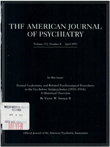Prevalence and stability of the DSM-III-R personality disorders in a community-based survey of adolescents
Abstract
OBJECTIVE: The purpose of this study was to estimate the prevalence, concurrent validity, and stability of DSM-III-R personality disorders in a large community-based sample of adolescents. METHOD: A randomly selected community sample of 733 youths ranging in age from 9 to 19 years was followed over a 2-year period. The protocol consisted of structured interviews with the adolescents and their mothers and self- report questionnaires. Algorithms for 10 DSM-III-R axis II disorders were developed to produce diagnoses at two levels of severity; these were validated against multiple indicators of distress and functional impairment. RESULTS: The overall prevalence of personality disorders peaked at age 12 in boys and at age 13 in girls and declined thereafter. Obsessive-compulsive personality disorder was the most prevalent moderate axis II disorder, narcissistic personality disorder the most prevalent severe disorder, and schizotypal personality disorder the least prevalent axis II disorder, based on both moderate and severe diagnostic thresholds. All moderate axis II disorders were associated with significantly greater odds for at least five of 12 diagnostic validators. Longitudinal follow-up revealed that although most axis II disorders did not persist over a 2-year period, subjects with disorders identified earlier remained at elevated risk for receiving a diagnosis again at follow-up. CONCLUSIONS: These findings suggest that a substantial minority of adolescents who are not in treatment qualify for DSM-III-R personality disorder diagnoses and that these diagnoses are associated with increased risk of psychological distress and functional impairment.
Access content
To read the fulltext, please use one of the options below to sign in or purchase access.- Personal login
- Institutional Login
- Sign in via OpenAthens
- Register for access
-
Please login/register if you wish to pair your device and check access availability.
Not a subscriber?
PsychiatryOnline subscription options offer access to the DSM-5 library, books, journals, CME, and patient resources. This all-in-one virtual library provides psychiatrists and mental health professionals with key resources for diagnosis, treatment, research, and professional development.
Need more help? PsychiatryOnline Customer Service may be reached by emailing [email protected] or by calling 800-368-5777 (in the U.S.) or 703-907-7322 (outside the U.S.).



